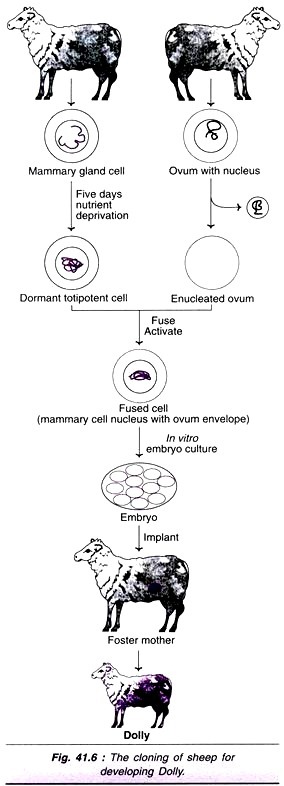Read this article to learn about the first ever mammal clone-Dolly.
Dolly, the first ever mammal clone was developed by Wilmut and Campbell in 1997. It is a sheep (female lamb) with a mother and no father.
The technique primarily involves nuclear transfer and the phenomenon of totipotency. The character of a cell to develop to different cells, tissues, organs, and finally an organism is referred to as totipotency or pluropotency.
Totipotency is the basic character of embryonic cells. As the embryo develops, the cells specialize to finally give the whole organism. As such, the cells of an adult lack totipotency. Totipotency was induced into the adult cells for developing Dolly.
The cloning of sheep for producing Dolly, illustrated in Fig. 41.6, is briefly described here. The mammary gland cells from a donor ewe were isolated. They were subjected to total nutrient deprivation (starvation) for five days. By this process, the mammary cells abandon their normal growth cycle, enter a dormant stage and regain totipotency character. An ovum (egg cell) was taken from another ewe, and its nucleus was removed to form an enucleated ovum.
The dormant mammary gland cell and the enucleated ovum were fused by pulse electricity. The mammary cell outer membrane was broken, allowing the ovum to envelope the nucleus. The fused cell, as it had gained totipotency, can multiply and develop into an embryo. This embryo was then implanted into another ewe which serves as a surrogate/foster mother. Five months later, Dolly was born. As reported by Wilmut and Campbell, they fused 277 ovum cells, achieved 13 pregnancies, and of these only one pregnancy resulted in live birth of the offspring-Dolly.
